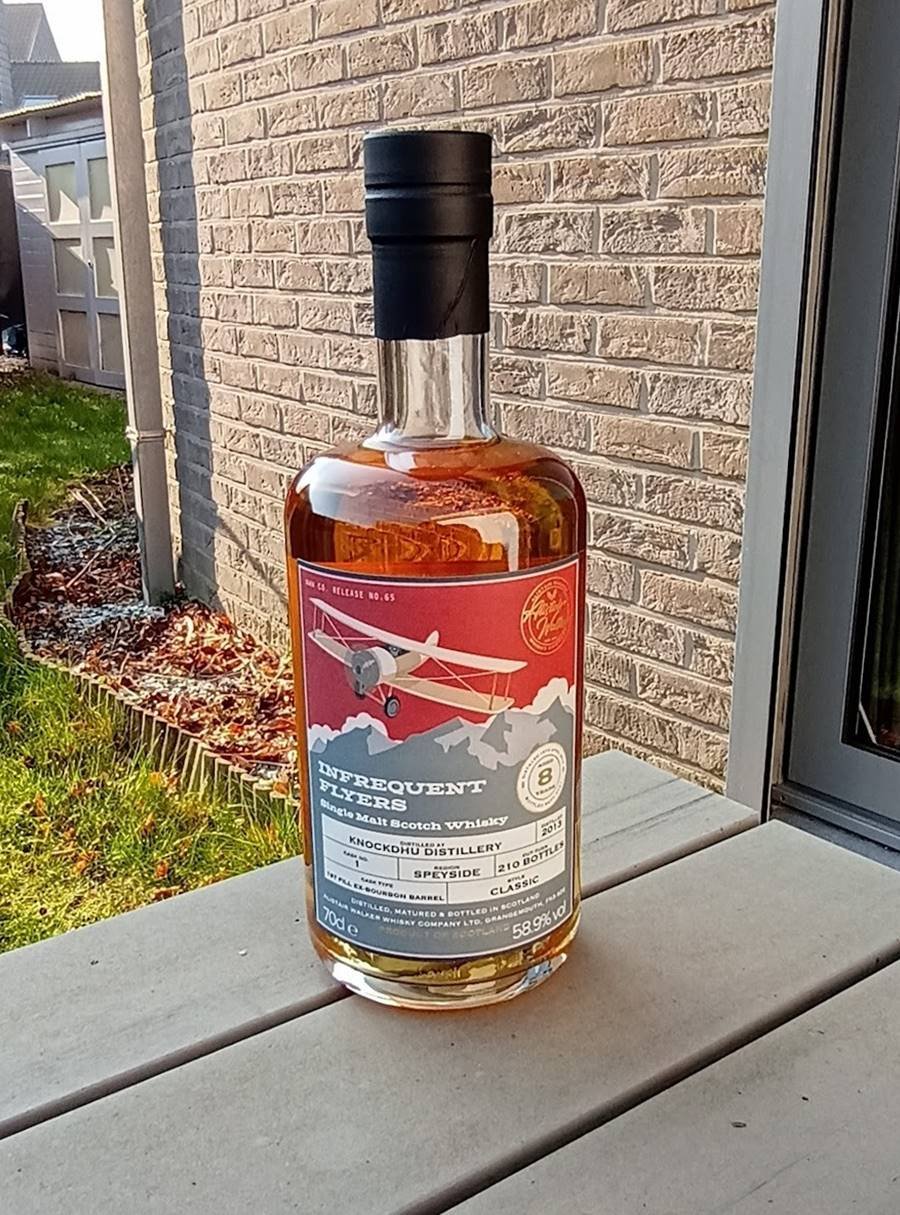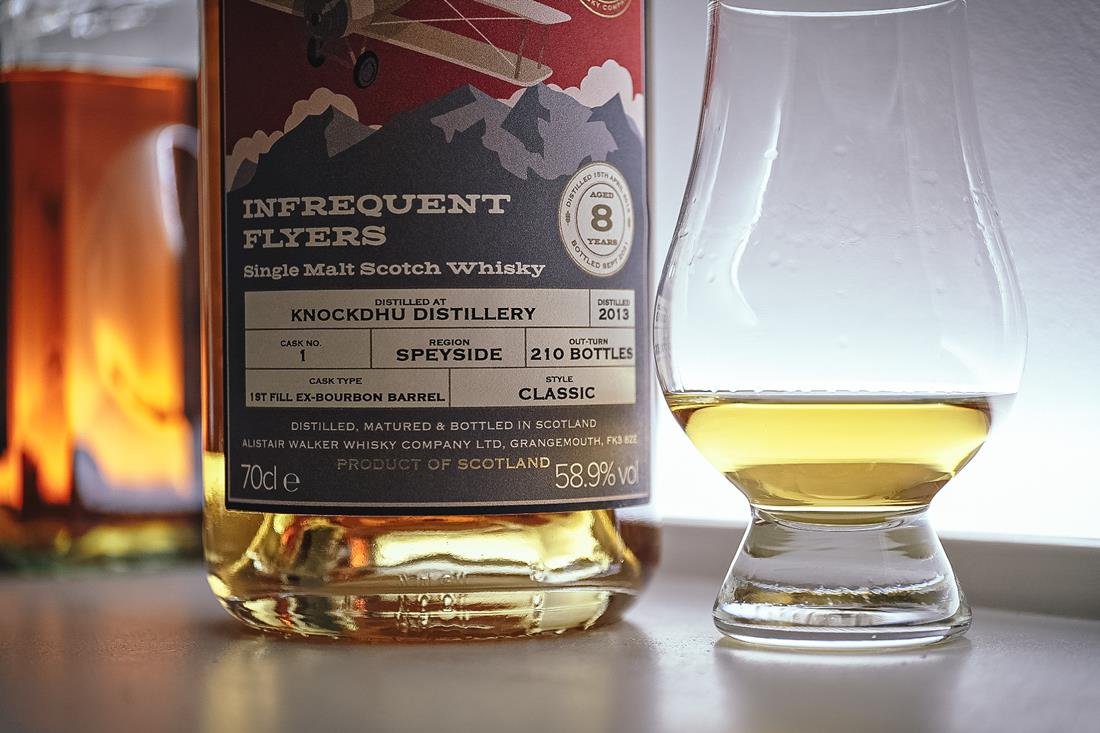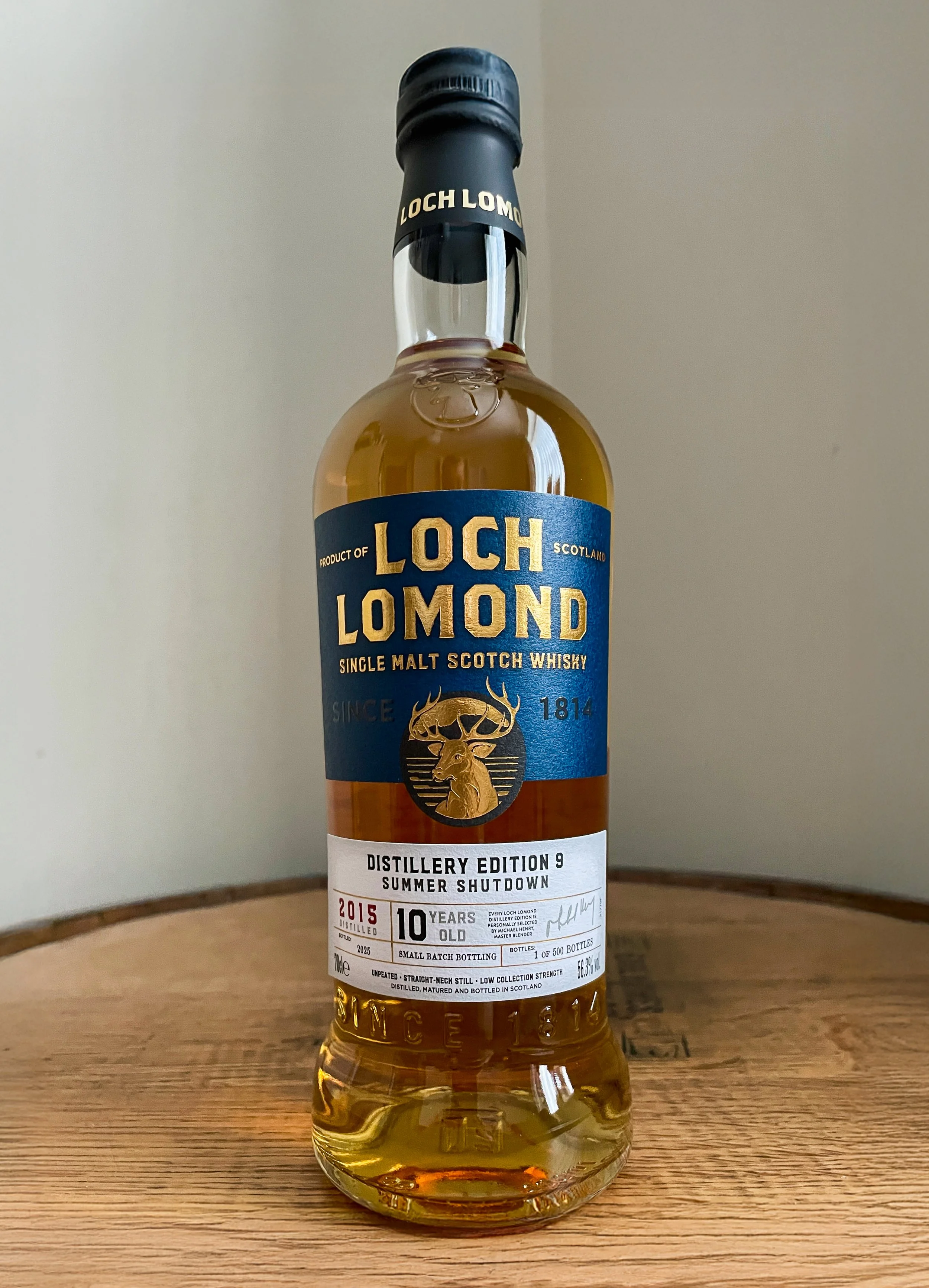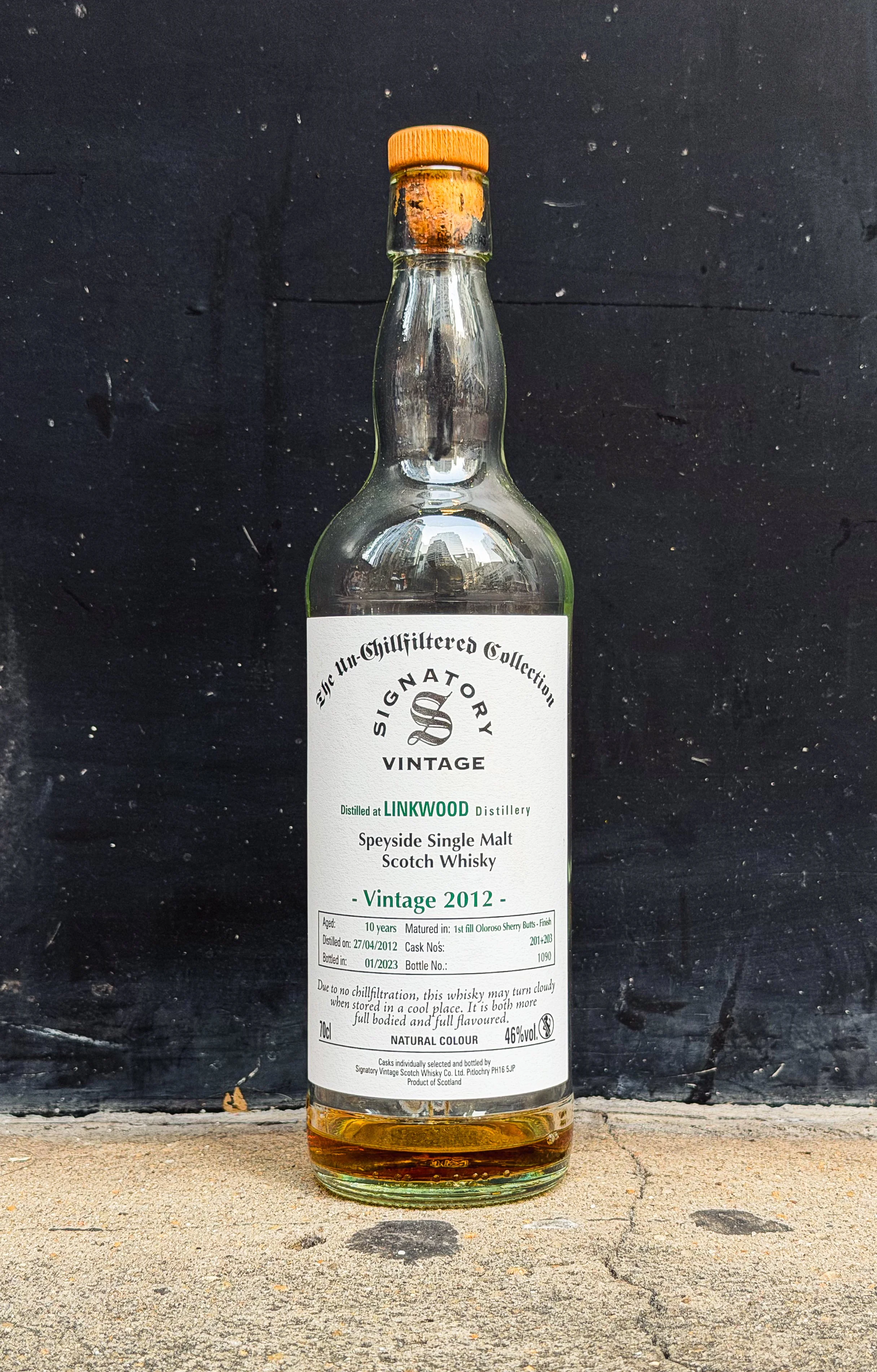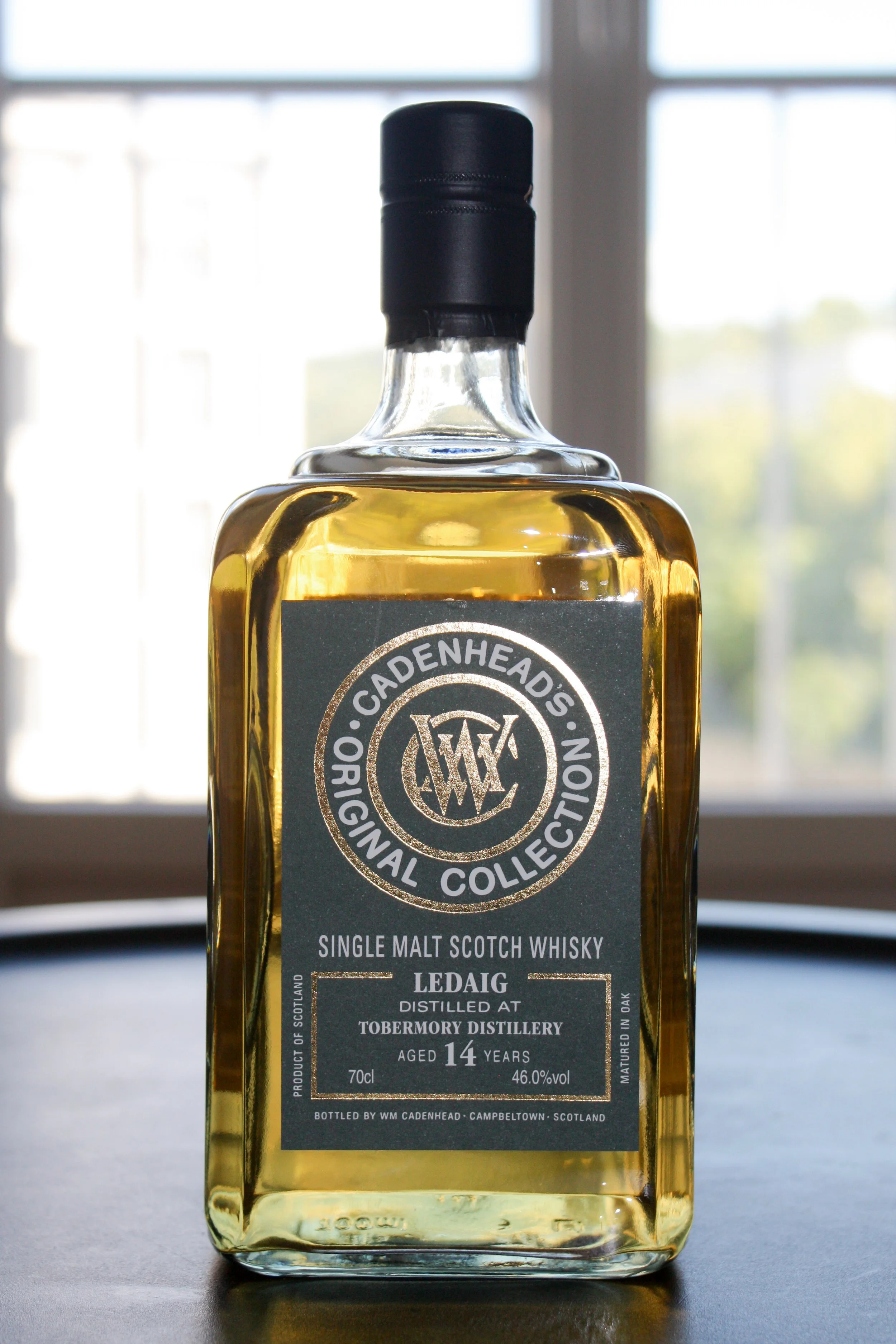Infrequent Flyers Knockdhu 8yo
Alistair Walker | 58.9% ABV
Score: 7/10
Very Good Indeed.
TL;DR
A famous playwright once wrote ‘What’s in a name?’ Quality, for starters, as it turns out
Focusing On Whisky That Is Available Rather Than Chasing The Unattainable, Is A Rewarding Thing
Getting into whisky is, I believe, a bit like learning to read. In order to really discover how to appreciate it and enjoy it, you have to cover the basics first. No one starts out reading (let alone enjoying) James Joyce, Dostoyevsky, or even Anthony Horowitz, for that matter. Just like no one starts their journey in whisky by grabbing a bottle of, say, Glen Scotia Victoriana or Port Charlotte 10, thinking this is the bomb.
No, if you’re here reading through these reviews and articles, I’m willing to bet good money you too at one point started out with something like Johnnie Walker black label, Glenfiddich 12 or Glenlivet Founder’s Reserve? And even though chances are none of these have been your epiphany whiskies – the whiskies that were a tipping point and ‘turned you’, I still think it’s fair to say a foundation of appreciation for what whisky is, can be found in these entry level, supermarket whiskies. No matter what your actual epiphany moment might have been – Lagavulin 16, Aberlour A’bunadh, Benromach 10…, whatever happens next is pretty much down to your own personal choices (both poor and good), but with a good mixture of coincidence thrown in for good measure. Often, discovering whisky is compared with a seemingly endless ride down a rabbit hole, and, as rabbit holes tend to go, it’ll be a ride filled with unexpected corners, ups and downs, bumps and steep descents. Very likely it also implies going down alleyways that split up into more alleyways, ensuring choices need to be made. This means you’re bound to ignore certain distilleries, or at least end up spending less time with them than if circumstances were to be different. To me, An’Cnoc (or to be more correct: Knockdhu) was, for a long time, down one of those alleyways I ran past, as I was busy chasing whatever it was I was chasing at the time. One of the best things about a rabbit hole however, is the fact that it’s not a one way street or a cul-de-sac, rather than a network of connected tunnels, leading you back to where you once were, thus allowing you to take that other alleyway and see where it leads you.
Going back and seeing what else is out there can be quite rewarding, as you stumble across unexpected yet very pleasant encounters. Craigellachie springs to mind, as do Glenrothes and Linkwood – three distilleries I probably should have connected with earlier on in my journey, but for whatever reason didn’t. Since then, I’ve spent more time with each, only to learn I really appreciate them. A similar thing happened a few years ago, when I (re)discovered a fairly obscure distillery right on the edge of Speyside and the Highlands. It’s a bit like meeting someone you really connect with, only to find out you’ve bumped into each other before, but were never properly introduced.
This then, is a story in two parts – but I promise I’ll do my best not to keep you (too) long. The first one is about a Speyside distillery with a bit of a peculiar history to it. The other is about a young indy bottler who seemed destined to step into the whisky business, if only because of his name.
Now, the distillery I’m talking about is of course Knockdhu, one of the 5 distilleries owned by Inver House, who, in turn, are owned by a Thai drinks consortium, ThaiBev.
As is the case with so many Scottish distilleries, changes in ownership are as common as rain over Glasgow, and Knockdhu is no exception. Over the course of their 130- ish years of existence, the opposite would in fact be quite exceptional.
Knockdhu distillery, 2017
Knockdhu was very purpose built, on a strategically interesting and very well chosen location, just outside the village Knock near the town of Keith. Close to a shiny new railway line, with a secure and abundant supply of both barley and peat in the immediate vicinity. Furthermore, it was commissioned by none other than DCL – the predecessor of what was to become whisky’s biggest juggernaut Diageo. DCL was, originally, a company founded in the late 19th Century, by the 6 biggest grain distilleries of that period, uniting their forces to safeguard their business interests against the pot still distilleries. By branching outside of the Lowlands and building a malt/pot still distillery in the Highlands/Speyside region, DCL was making a statement that it was ready to pick up the gauntlet thrown by their pot still distilling adversaries.
With the 20th century in sight, there was an ongoing and often quite heated debate on what defined Scotch whisky. Particularly, the pot still distilleries weren’t too happy with the bulk producing column still distilleries from the Lowlands, accusing them of creating inferior spirits and thus damaging their reputation. And, truth be told, they did have a case. The status of grain spirit throughout the larger part of the 19th century wasn’t helped much by the fact that a great deal of the spirit was destined to end up south of the border to be made into gin in England, although over time increasing amounts were also purchased by blenders like Dewar’s, Buchanan’s, Usher and Walker & Sons.
Towards the end of the 19th century, as Scotch started to make a name for itself well beyond its own borders, cheap grain whisky flooded the market, much to the despair of the malt distilleries who couldn’t compete with the dirt cheap prices of grain spirit, and as there was little to no legal description of what qualified as scotch whisky, it was pretty much anyone’s game. The almost inevitable dispute between malt distilleries and grain distilleries got so ugly, that it ended in court as malt distilleries tried to ban who they saw as their competitors from calling their product ‘whisky’. They claimed the mass produced grain whiskies were not ‘proper Scotch whisky’, because they were releasing products of far inferior quality and therefore threatening the reputation of their own product. And while the verdict left the pot still distilleries with the shorter of the two straws, it did set the wheels in motion to get some sort of legal notion about the nature and characteristics of what was ‘Scotch whisky’.
In hindsight, it reads as a yet another rather nasty page in the long-lasting chapter on the conflict that existed between the richer (keenly focused on London) gentry from the Lowlands and the rugged, clan orientated, more independent folk of the Highlands. And while it’s not unreasonable to believe that some of those Lowland whisky barons threw their weight around in order to get a favourable ruling of the court, in even more hindsight, it is fair to conclude that as a consequence of the ruling in favour of the column still distilleries, the path was cleared for blended Scotch whisky to start conquering the world.
“Among the distilleries closed ‘permanently’ during the bad years of the mid 1980s, Knockdhu was the first to reopen. Its resuscitation was a sign of the revival in the fortunes of the Scotch whisky industry as the decade approaches its end.”
Back to Knockdhu. For almost a century it lived a busy, yet perhaps rather anonymous life, being one of many workhorse malt distilleries owned by DCL, until it became redundant during the whisky loch of the 1980s. Closed, yet not forgotten, as Inver House (a company which in turn was initially founded as a subsidiary of an American drinks business in the 1960s, until becoming independent in the 1980s) was looking to expand their portfolio, making the then silent Knockdhu, the first distillery they purchased. The stills were once again fired up in 1989 and the An’Cnoc single malt brand was born shortly after. And while it never reached a cult status like Ardbeg, Highland Park or Macallan, Knockdhu as one of few distilleries still using worm tubs for cooling the new make from the spirit still, has been embraced by many enthusiasts, singing its praise and cherishing it for its layered, rewarding and versatile malts. With a production capacity of roughly 1.5 – 1.75 Mio LPA, it’s by no means a colossus, which might explain why there isn’t an awful lot to go around for the indie bottlers. Even if you were to go back from now to about 2017 and counted the independent bottlings, you’d struggle to come up with more than 20 or 30 indie releases. I for one, never had an independent Knockdhu, let alone a cask strength expression, so when I saw on the interweb that one of my favourite stores had it on the shelves … well, let’s just say I made a little detour on my daily commute back home that day.
Which brings me nicely to the second part of this story. Alistair Walker, it seems, was destined to end up in the drinks business. With a name like ‘Walker’ you’re pretty much already halfway there in any case, but, just to be clear, I’m not referring to ‘that’ brand with The Striding Man. I’m talking about Alistair being the son of a certain William, otherwise known as Billy Walker, a living legend of the whisky industry. As a part of Billy Walker’s team for over 20 years, first at Burn Stewart, later with the BenRiach company, Alistair was shown the ropes and made his career mostly in sales and marketing, before BenRiach, Glendronach and Glenglassaugh were sold to Brown-Forman some 5 years ago. With Billy Walker shortly after taking over Glenallachie, Alistair decided to start for himself, founding the Alistair Walker Whisky Company in 2018, releasing their first batch of single cask, cask strength whiskies in 2019. As he described it rather tongue in cheek, ‘making the move from distillery to independent bottler is very much a case of gamekeeper turned poacher.’
Stills at Knockdhu
Review
210 bottles, 2008, bourbon barrel, 58.9% ABV
£52-£55 if you shop around
Rather than relying on the Walker name to do the talking in terms of marketing, which would have been the easy, obvious way forward, I feel it’s commendable that, whilst not hiding the name, they’re focussing strongly on the actual product with the Infrequent Flyers branding. The philosophy behind the series, which is about putting the spotlight on some of the lesser known distilleries of Scotland, translates beautifully with the classy, contemporary yet timeless branding featuring old school double-decker planes on the labels. And while a good looking bottle tells you pretty much nothing about the quality of its contents, there is something to be said for brand recognisability. Combining looks with the factual information we like to see as enthusiasts (vintages, origins, cask type, ABV, natural presentation etc.) rather than coming up with yet another farfetched, bogus story cramped with the usual and predictable marketing flannel, is the way to go, I feel.
Nose
Despite this being a near 59% ABV whisky, all remains civil when nosing. Creamy, grainy, with vanilla and vanilla oil and white sugar. There is definitely something savoury there as well, as well as a grassy-floral-lemongrass touch. Thyme, heather and honey. Youthful, yes, yet layered. Robust, yet also nuanced, subtle and complex. Add some water – it can take it – and the fragrant & floral notes open up alongside a white fruit sweetness (melons), with honey, vanilla and lemon sherbet.
Palate
On first sip, immediately the ABV roars: hot, spicy and peppery indeed, allowing for little more than a sweet cereal note and something vaguely grassy-floral. Adding water is – I feel – mandatory. Now, there‘s room for a floral-heather note to show up, which turns spicy and herbaceous. Even after a decent amount of water, the texture and mouthfeel remain medium full, oily and syrupy. The sweetness from the vanilla and honey notes are still present, but have been pushed back and just as they emerged, they rapidly evolve mid palate into a savoury note with hints of mushrooms. That umami note lingers on in a medium long finish, accompanied by a warming, dry and sweet spiciness.
Score: 7/10
Score: 7/10
Very Good Indeed.
TL;DR
My whisky of the year, for a reason
Dougie’s Notes
I celebrated this very bottle as my pick of 2021, after a year where I went from abject ignorance of whisky to passionate ambassador of the incredible, viscous golden liquid. I have tried many dozens of whiskies since January 2021, after I realised whisky was for me, but it was this Knockdhu 8yo, purchased in November 2021, that took the best-in-show prize. Such a late entry, yet so competent and exciting that I couldn’t move past it as being the best of my collective bunch.
At November’s point in my whisky timeline, I had already been quite a fan of Alistair Walker and his Infrequent Flyers range of whisky. To date, I have had 8 of his bottles on my whisky shelf; from liquid raisin Glenrothes to leather shop Deanston, I love the whole concept of what Alistair is doing with his indie bottling endeavour. Pure whisky, nothing else. The particulars are on the label, if you so desire, presented with very little fluff or pomp. If you fancy an unadulterated cask strength whisky, often from obscure distilleries, then the Flyer’s range will suit you to a tee.
Nose
Roasted coffee that’s been left to cool. Marker pens and warm polished wood furniture in a French chateau whilst a tour guide barks at you to move quicker. Chalky concrete dust and airport perfume aisles - one in particular springs to the forefront, and it’s the Spice Bomb. A grenade of spicy, woody sweetness, but not ejected straight out the bottle, instead after a day of work - a hard earned funkiness amidst fading sweetness.
Palate
Creamy vanilla custard pastry. There’s a lovely perfumed planty sweetness - heather I suppose. Orange blips appear, manifesting into candied orange topped vanilla cupcakes. Delicious edge of warm bread and butter pudding with melty chocolate nibs snuck in. One last tiny sip of the glass, delivers a chocolate orange slap, and I am eternally grateful.
Score: 7/10
The Dregs - EA
If you’ve made it this far, then I can only applaud your perseverance, and please accept my apologies as this has turned into quite a lengthy review. If ever there was a time to get to the point, this is probably it: a young, complex whisky, but above all, versatile and a lovely beauty!
The Dregs - DC
I bought a few more bottles of this Knockdhu after I opened the first, and I’ve told anyone that'll listen about how good it is. It resonates with me, and is a magnificent liquid to sit and pick apart. It’s not overly challenging, or heavily sherried, or peated, or super sweet. It’s a harmonised cacophony of little bitter citrus pops rounded over with indulgent custardy, buttery sweetness. A citrus spritz heightens the whole experience, taking the potentially overly sweet landscape down to a deliciously complex, yet surprisingly easy drinking whisky. Cask strength at 58.9%, I can sip away and not be bowled over with waves of spice or heat. Yet adding water doesn’t impact the joy one bit - it opens it up, revealing more of those subtle bitter and citrus notes amongst the quaffable vanilla custard. Supremely enjoyable dram.
Tried this? Share your thoughts in the comments below. EA
-
Dramface is free.
Its fierce independence and community-focused content is funded by that same community. We don’t do ads, sponsorships or paid-for content. If you like what we do you can support us by becoming a Dramface member for the price of a magazine.
However, if you’ve found a particular article valuable, you also have the option to make a direct donation to the writer, here: buy me a dram - you’d make their day. Thank you.
For more on Dramface and our funding read our about page here.

